Lancia Delta 2010 Owner handbook (in English)
Manufacturer: LANCIA, Model Year: 2010, Model line: Delta, Model: Lancia Delta 2010Pages: 276, PDF Size: 5.31 MB
Page 221 of 276

35 70 105 140 175
●● ● ● ●
●
●
●●
●●
●● ● ● ●
●●
●● ● ● ●
220CARE AND MAINTENANCE
Thousands of kilometres
Check engine management system operation (via diagnostic socket)
Replace auxiliary drive belt
Replace toothed timing drive belt (*)
Replace fuel filter
Replace air filter cartridge
Change engine oil and oil filter (versions without DPF) (or every 24 months)
Change engine oil and oil filter (versions with DPF) (**)
Change brake fluid (or every 24 months)
Change pollen filter (or every 15 months)
(*) Regardless of the km covered, the timing belt should be replaced every 4 years for particularly demanding use (cold climates,
driving in the city, idling for a long time) or in any case every 5 years.
(**) The engine oil and the filter must be changed when the instrument panel warning light comes on (see “Warning lights and
Messages” chapter) and in all cases every 2 years.
If the car is used mainly in towns the engine oil and filter need to be changed every 12 months.
215-242 Delta 3ed gb 11-11-2009 12:14 Pagina 220
Page 222 of 276
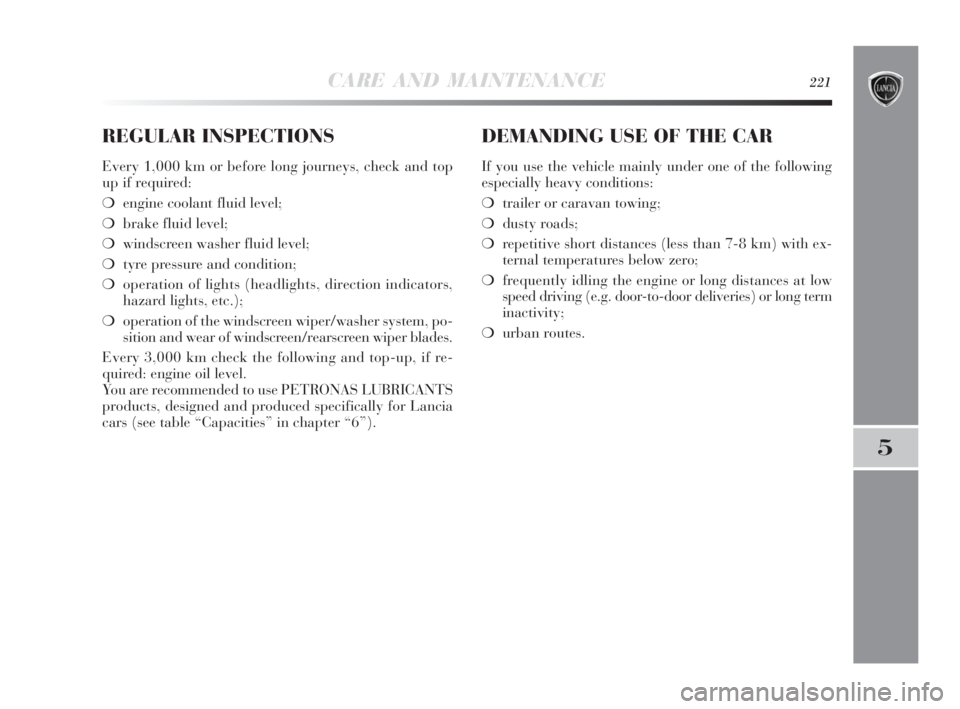
CARE AND MAINTENANCE221
5
REGULAR INSPECTIONS
Every 1,000 km or before long journeys, check and top
up if required:
❍engine coolant fluid level;
❍brake fluid level;
❍windscreen washer fluid level;
❍tyre pressure and condition;
❍operation of lights (headlights, direction indicators,
hazard lights, etc.);
❍operation of the windscreen wiper/washer system, po-
sition and wear of windscreen/rearscreen wiper blades.
Every 3,000 km check the following and top-up, if re-
quired: engine oil level.
You are recommended to use PETRONAS LUBRICANTS
products, designed and produced specifically for Lancia
cars (see table “Capacities” in chapter “6”).
DEMANDING USE OF THE CAR
If you use the vehicle mainly under one of the following
especially heavy conditions:
❍trailer or caravan towing;
❍dusty roads;
❍repetitive short distances (less than 7-8 km) with ex-
ternal temperatures below zero;
❍frequently idling the engine or long distances at low
speed driving (e.g. door-to-door deliveries) or long term
inactivity;
❍urban routes.
215-242 Delta 3ed gb 11-11-2009 12:14 Pagina 221
Page 223 of 276
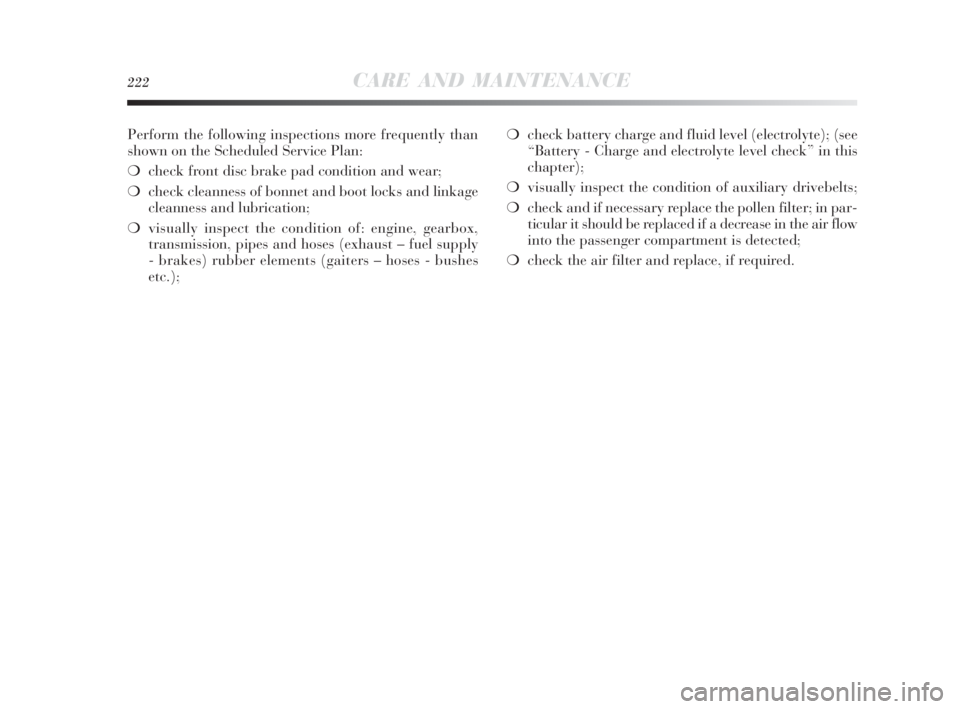
222CARE AND MAINTENANCE
Perform the following inspections more frequently than
shown on the Scheduled Service Plan:
❍check front disc brake pad condition and wear;
❍check cleanness of bonnet and boot locks and linkage
cleanness and lubrication;
❍visually inspect the condition of: engine, gearbox,
transmission, pipes and hoses (exhaust – fuel supply
- brakes) rubber elements (gaiters – hoses - bushes
etc.);❍check battery charge and fluid level (electrolyte); (see
“Battery - Charge and electrolyte level check” in this
chapter);
❍visually inspect the condition of auxiliary drivebelts;
❍check and if necessary replace the pollen filter; in par-
ticular it should be replaced if a decrease in the air flow
into the passenger compartment is detected;
❍check the air filter and replace, if required.
215-242 Delta 3ed gb 11-11-2009 12:14 Pagina 222
Page 224 of 276
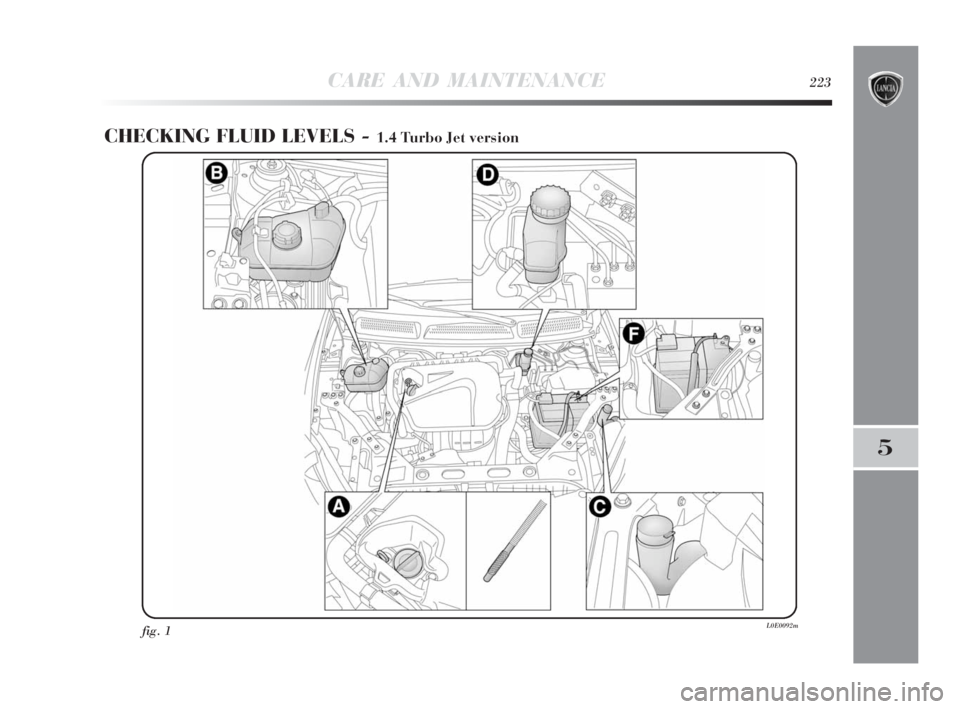
CARE AND MAINTENANCE223
5
CHECKING FLUID LEVELS - 1.4 Turbo Jet version
fig. 1L0E0092m
215-242 Delta 3ed gb 11-11-2009 12:14 Pagina 223
Page 225 of 276
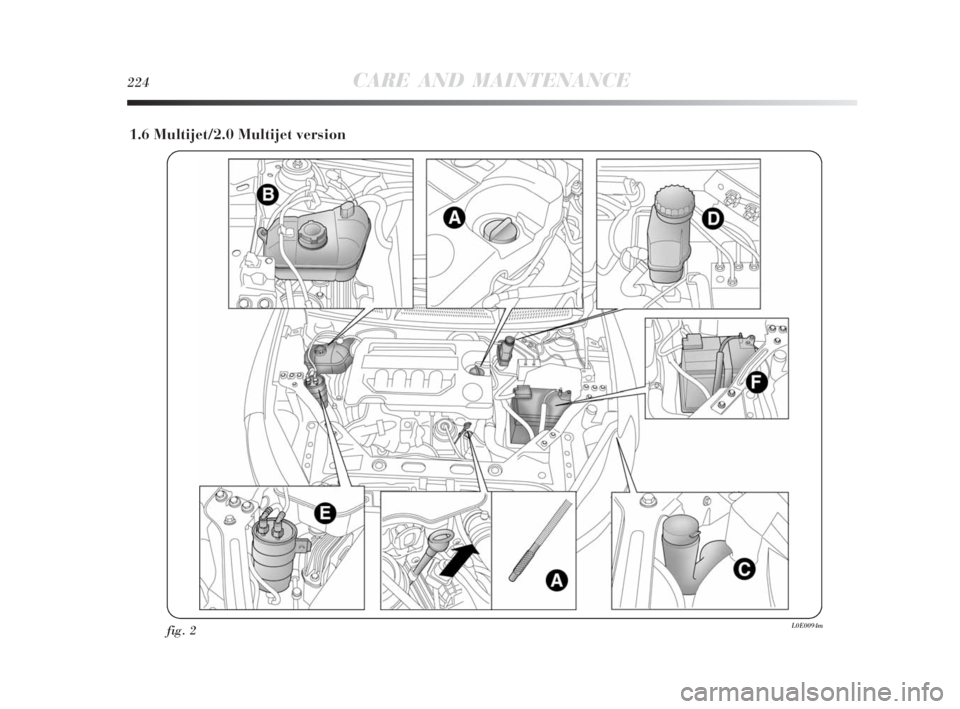
224CARE AND MAINTENANCE
1.6 Multijet/2.0 Multijet version
fig. 2L0E0094m
215-242 Delta 3ed gb 11-11-2009 12:14 Pagina 224
Page 226 of 276
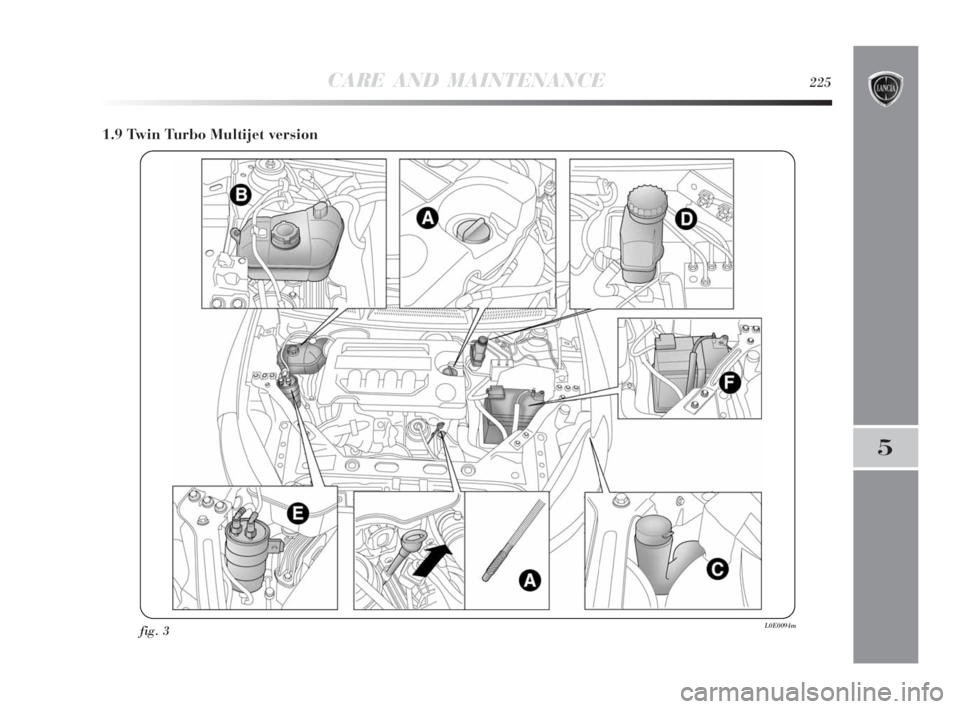
CARE AND MAINTENANCE225
5
1.9 Twin Turbo Multijet version
fig. 3L0E0094m
215-242 Delta 3ed gb 11-11-2009 12:14 Pagina 225
Page 227 of 276

226CARE AND MAINTENANCE
ENGINE OIL A-fig. 1-2-3
Check the oil level a few minutes (about 5) after the en-
gine has stopped, with the car parked on level ground. The
oil level should be between the MIN and MAX marks on
the dipstick. The range between the MIN and MAX lev-
els corresponds to approximately 1 litre of oil.
If the oil level is near or under the MIN line, add oil
through the filler to reach the MAX line.
The oil level should never exceed the MAX line.Engine oil consumption
The maximum engine oil consumption is usually 400
grams every 1000 km. When the car is new, the engine
needs to be run in, therefore the engine oil consumption
can only be considered stabilised after the first 5,000 -
6,000 km.
IMPORTANT The oil consumption depends on driving
style and the conditions under which the car is used.
IMPORTANT After adding or changing the oil, let the en-
gine turn over for a few seconds and wait a few minutes
after turning it off before you check the level.
215-242 Delta 3ed gb 11-11-2009 12:14 Pagina 226
Page 228 of 276
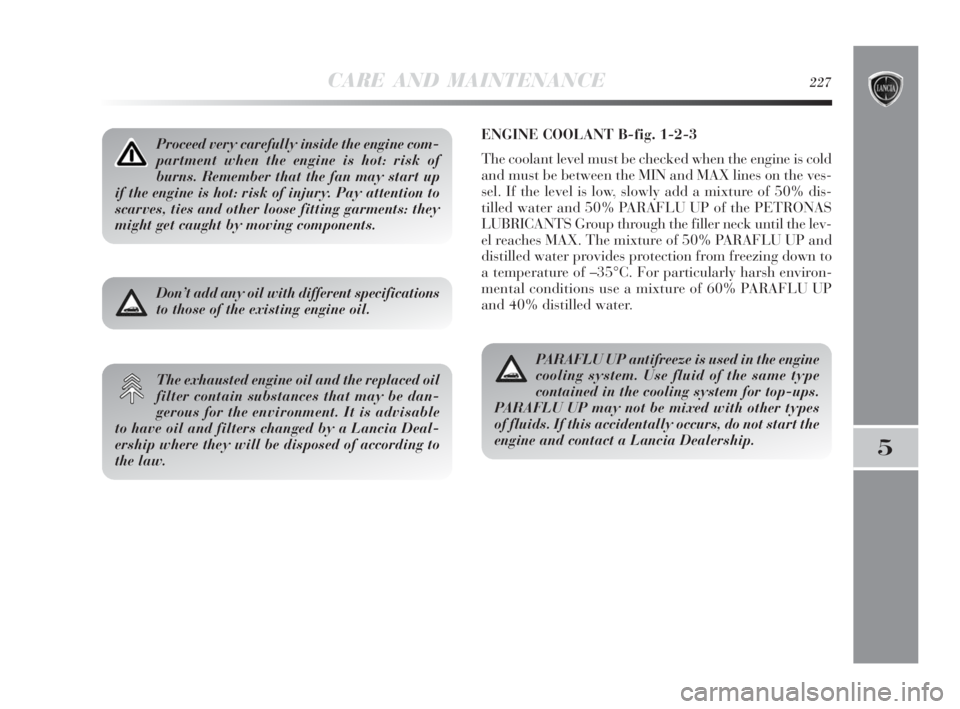
CARE AND MAINTENANCE227
5
ENGINE COOLANT B-fig. 1-2-3
The coolant level must be checked when the engine is cold
and must be between the MIN and MAX lines on the ves-
sel. If the level is low, slowly add a mixture of 50% dis-
tilled water and 50% PARAFLU UP of the PETRONAS
LUBRICANTS Group through the filler neck until the lev-
el reaches MAX. The mixture of 50% PARAFLU UP and
distilled water provides protection from freezing down to
a temperature of –35°C. For particularly harsh environ-
mental conditions use a mixture of 60% PARAFLU UP
and 40% distilled water.Proceed very carefully inside the engine com-
partment when the engine is hot: risk of
burns. Remember that the fan may start up
if the engine is hot: risk of injury. Pay attention to
scarves, ties and other loose fitting garments: they
might get caught by moving components.
Don’t add any oil with different specifications
to those of the existing engine oil.
The exhausted engine oil and the replaced oil
filter contain substances that may be dan-
gerous for the environment. It is advisable
to have oil and filters changed by a Lancia Deal-
ership where they will be disposed of according to
the law.
PARAFLU UP antifreeze is used in the engine
cooling system. Use fluid of the same type
contained in the cooling system for top-ups.
PARAFLU UP may not be mixed with other types
of fluids. If this accidentally occurs, do not start the
engine and contact a Lancia Dealership.
215-242 Delta 3ed gb 11-11-2009 12:14 Pagina 227
Page 229 of 276
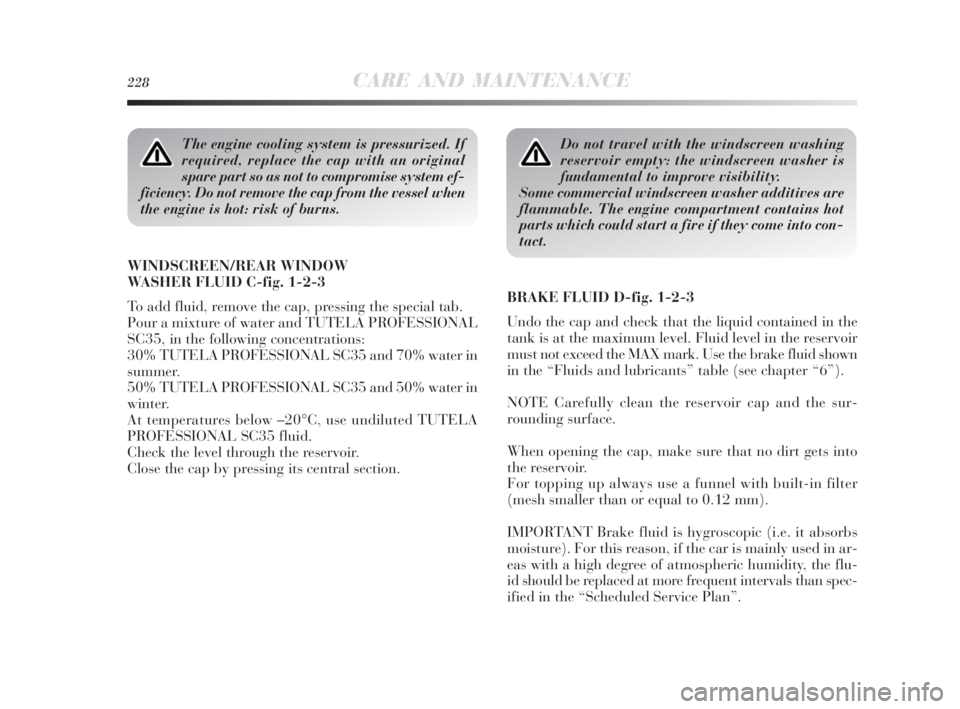
228CARE AND MAINTENANCE
The engine cooling system is pressurized. If
required, replace the cap with an original
spare part so as not to compromise system ef-
ficiency. Do not remove the cap from the vessel when
the engine is hot: risk of burns.
WINDSCREEN/REAR WINDOW
WASHER FLUID C-fig. 1-2-3
To add fluid, remove the cap, pressing the special tab.
Pour a mixture of water and TUTELA PROFESSIONAL
SC35, in the following concentrations:
30% TUTELA PROFESSIONAL SC35 and 70% water in
summer.
50% TUTELA PROFESSIONAL SC35 and 50% water in
winter.
At temperatures below –20°C, use undiluted TUTELA
PROFESSIONAL SC35 fluid.
Check the level through the reservoir.
Close the cap by pressing its central section.
Do not travel with the windscreen washing
reservoir empty: the windscreen washer is
fundamental to improve visibility.
Some commercial windscreen washer additives are
flammable. The engine compartment contains hot
parts which could start a fire if they come into con-
tact.
BRAKE FLUID D-fig. 1-2-3
Undo the cap and check that the liquid contained in the
tank is at the maximum level. Fluid level in the reservoir
must not exceed the MAX mark. Use the brake fluid shown
in the “Fluids and lubricants” table (see chapter “6”).
NOTE Carefully clean the reservoir cap and the sur-
rounding surface.
When opening the cap, make sure that no dirt gets into
the reservoir.
For topping up always use a funnel with built-in filter
(mesh smaller than or equal to 0.12 mm).
IMPORTANT Brake fluid is hygroscopic (i.e. it absorbs
moisture). For this reason, if the car is mainly used in ar-
eas with a high degree of atmospheric humidity, the flu-
id should be replaced at more frequent intervals than spec-
ified in the “Scheduled Service Plan”.
215-242 Delta 3ed gb 11-11-2009 12:14 Pagina 228
Page 230 of 276

CARE AND MAINTENANCE229
5
The brake fluid is poisonous and highly cor-
rosive. In case of accidental contact, wash the
parts with water and mild soap and rinse
with plenty of water. If swallowed immediately call
a doctor.
Prevent brake fluid which is highly corrosive
from coming into contact with painted parts.
Should this occur, immediately wash with
water.
The symbol πon the container indicates a
synthetic brake fluid, which is different from
a mineral fluid. Use of a mineral-based flu-
id will damage the special rubber seals of the brak-
ing system beyond repair.
The brake fluid is poisonous and highly cor-
rosive. In the event of accidental contact,
wash the parts with water and mild soap and
rinse with plenty of water. If swallowed immedi-
ately call a doctor.
The symbol πon the container indicates a
synthetic brake fluid, which is different from
a mineral fluid. Use of a mineral-based flu-
id will damage the special rubber seals of the brak-
ing system beyond repair.
215-242 Delta 3ed gb 11-11-2009 12:14 Pagina 229